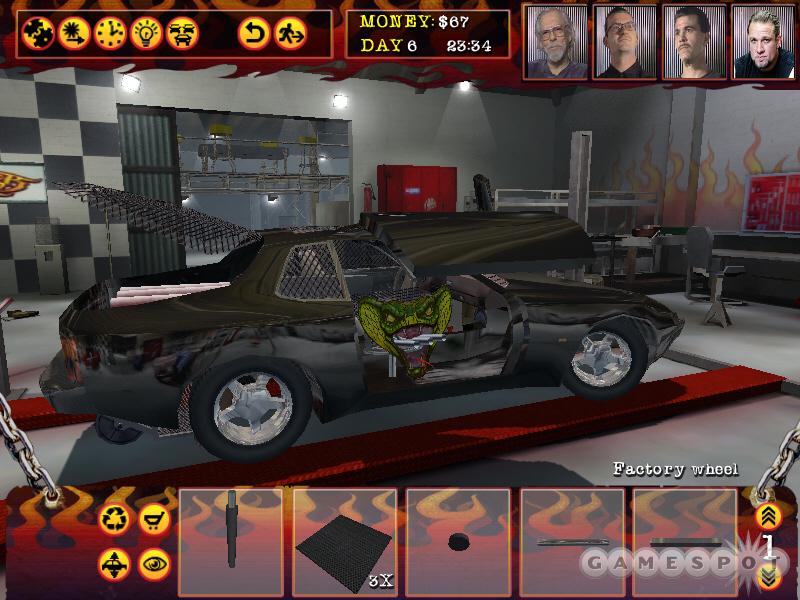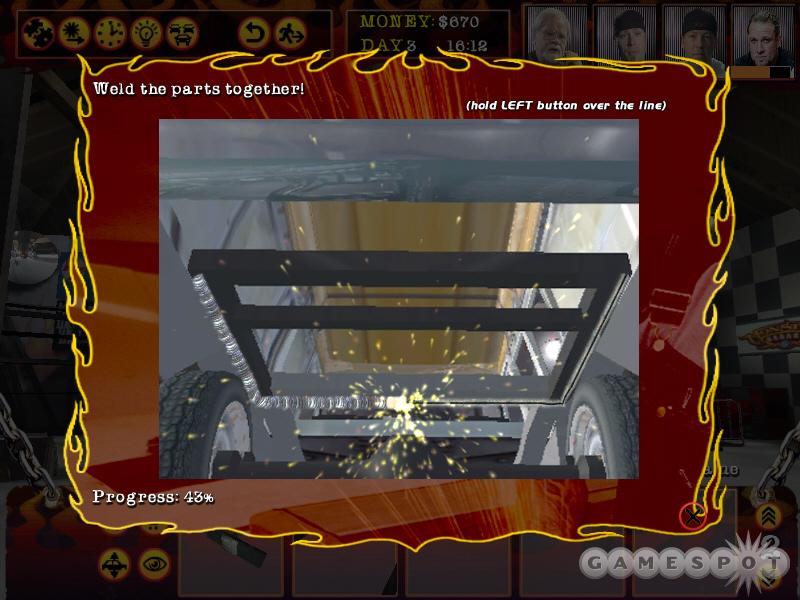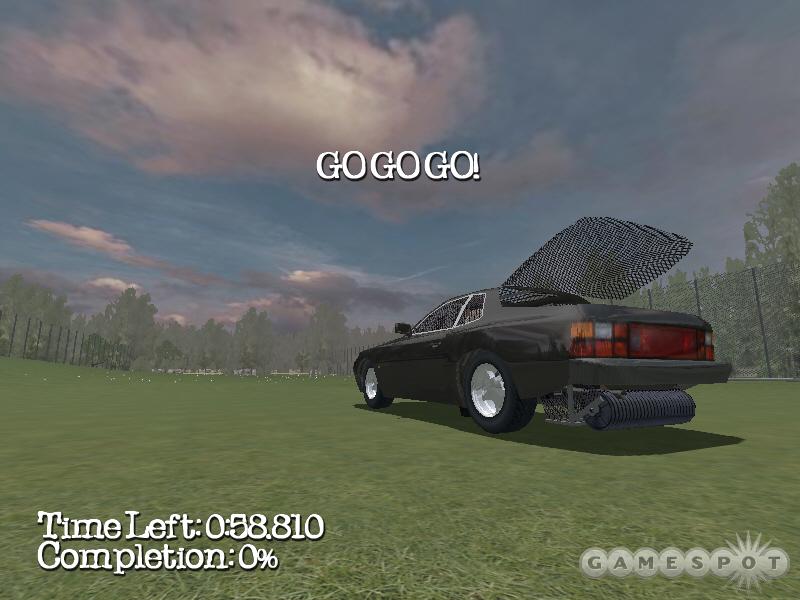Those who regularly watch the Discovery Channel will undoubtedly know the name Monster Garage. It's the show where motorcycle guru Jesse James and his team transform a vehicle into a functional machine with a purpose. It's no surprise that the fun, dynamic show would branch into computer gaming. Unfortunately, though, the developers of the Monster Garage couldn't transform the concept into a functional game. The lack of any strategy to the gameplay, a generally poor design, and an endless number of stability problems turn Monster Garage into a real monster, all right.

The Monster Garage TV show works like this: Jesse James and a group of specialists are given a task. For example, they may have to convert an RV into a mobile skate ramp, or they may have to convert a Porsche into a golf ball retriever. It's not that easy, though, because the team has to complete the project in seven days and is only given a budget of $3,000. The team is allowed to sell unused parts that have been stripped from the work-in-progress vehicle to earn extra cash, though. The computer game version gives you seven challenges that follow these show-specific rules. However, fans of the series who are expecting something new will be disappointed to learn that the game uses challenges that have been lifted straight from the TV show.
Each challenge in the game is split into four phases: design, construction, decoration, and trial. Day one is solely devoted to picking a design. The first couple of challenges only let you choose one design, but the latter challenges allow you to pick one of three designs. Days two through six are spent chopping up the vehicle, ordering materials, creating custom parts, and attaching parts to the "monster." If you click on a team member, you'll see a list of tasks that he or she can perform. Each task takes a certain amount of time, and adding or subtracting parts from the vehicle also eats up the clock. On day seven, you are allowed to customize your monster with paint jobs and decals. When finished, you'll actually get to drive your monster in a contest that's specific to that vehicle. For example, the rock climbing vehicle has to reach three checkpoints before the timer runs out, while the limo-fire truck has to put out a fire.
And that's all Monster Garage has to offer. It truly is as straightforward as the above paragraph describes. This is because each challenge has a paint-by-numbers approach. There is only one way to build the monster. You can't cut any corners. You can't construct anything cool on your own. Nope, Jesse is going to build a roll cage the same way every time. If you get stumped, a video will give you a part-by-part installation blueprint on how to build the monster, so there's no mystery about what you need. There's a little guessing involved in how to build some of the parts, but all you need to do is buy one of each raw material. The "team" members will then reveal what they need to fabricate custom parts.

We put "team" in quotation marks because this is another huge disappointment in the Monster Garage game. Most of the TV show's excitement comes from the team's interaction. They talk and hang out, but more importantly, they get intense when there is tension after a setback. You'll find none of this interaction in the game. In fact, you never even know who your teamis because no one is introduced. All you ever see are four portraits in the top right corner of the screen. That's right, only four team members are in the game version, one of whom is always Jesse James. What's even more incredulous is that each team member has the exact same skills. Jesse will take just as long to weld a custom axle as any of the other three team members. It would have been interesting if the team members had strengths and weaknesses, like they do in real life. You would then be forced to plan out your part schedule to make sure that you could finish in time. But alas, the game results in a simple "click-fest" when handing out assignments.
Attaching or removing parts isn't any better. For example, say you want to remove a wheel. You first click on the wheel to bring up a close-up view of it, along with five lug nuts. You simply click the mouse on each lug nut to loosen it--and voilà! The wheel is removed. Welding is even worse. You'll trace a line with a torch to magically attach parts to the vehicle. These tasks actually aren't so bad in themselves. In fact, it's quite exciting to start a new challenge to find what you can tinker with--but it gets old quickly. You can't skip these mundane activities, so you'll have to loosen five lug nuts on all four tires to remove the wheels every time. You'd wish you could skip them if you needed to restart the challenge--like if the game crashed on you.
Monster Garage had some monster stability issues on our machines. It's been reported that the game is most unstable on Windows XP machines, but there are still numerous other bugs unrelated to operating systems. Simple things like clicking on an arrow too quickly may cause the game to crash to the desktop. Sometimes the game will freeze up. On our sixth mission, one of the designs for the golf ball retriever actually caused the vehicle to fall through the gameworld. Monster Garage also suffers from some terrible interface design. Once you start a game, you can't get back to the main menu without saving the game. The only way you can get back to the menu is by selecting the "save and exit to menu" option. In fact, this is the only way you can save a game. Due to its frequent crashes, the game would be better if there was some easier way to quickly save it. If you don't want to save and would rather load another game (or if you'd like to quit), you have to press Alt-F4 to relaunch Monster Garage.

The activity timing could have also been tweaked. When you add or remove parts, the times seem to be arbitrary. For example, according to the game, it takes the team 20 minutes to remove one tire. Aren't these guys supposed to be experts? If you make it past day seven, congratulations! Now you get to test your monster in a driving simulation. For example, the lawn mower needs to cut a certain percentage of a field while driving up and down the grass. Sometimes it can be fun to finally get out of the shop, but this desire fades quickly because of the rudimentary execution of driving in the game. In the TV show, the monster must defeat a standard machine at its own game. Jesse would have to cut grass with the Ford Mustang lawn mower faster than a real lawn mower. But alas, you'll be driving in the fields all alone in the game version, which is just as well because the physics are rather absurd, particularly in the first three missions. You'll skid, slide, and flip over countless times before you can finesse the system.
The driving portion puts you in a small, controlled environment with bland textures. You'll notice clipping in some parts, especially when the water is inside the supposedly waterproof swamp buggy. Car models look fairly similar to their origins, though parts do tend to be blocky and have low-resolution textures. The game has a radio function that plays fitting heavy metal music, but the track selection is limited. The shop sounds, like torches and power tools, are appropriate and are perhaps the only portion of the game that can say this.

There really isn't much to keep you playing Monster Garage. Even if you brave all the crashing, the game will take you only a few hours to complete. The challenges are all easy, except for the final one. This is unfortunate because the last challenge is actually enjoyable and is significantly harder than the others--and it requires you to make some sort of plan. Additionally, you can't fault the linear approach to building the monster. Let's face it--you do need to install parts in a given order in construction. However, you can fault the game for being so inflexible with the parts themselves. Why can't we build a roll cage with fewer cross beams in order to save money? If the in-game engine was more complex, to allow for damage modeling, you could have had this trade-off. Was saving a few bucks really worth the risk of damaging the vehicle in the trial? You should be able to ask yourself this same question in regard to the game. Is it worth saving a few bucks to avoid a frustrating and empty game? We think so.